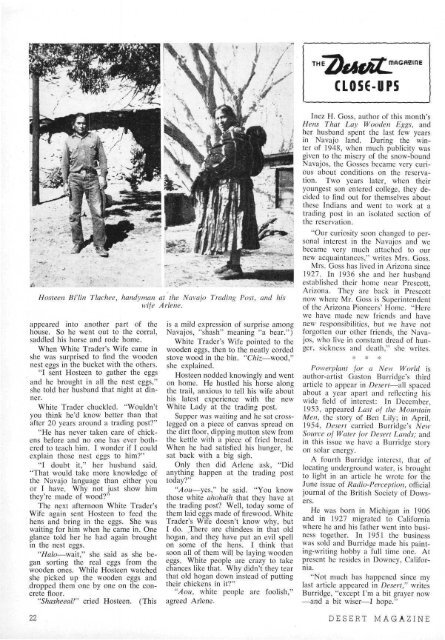HIr - Desert Magazine of the Southwest
HIr - Desert Magazine of the Southwest
HIr - Desert Magazine of the Southwest
Create successful ePaper yourself
Turn your PDF publications into a flip-book with our unique Google optimized e-Paper software.
Hosteen Bi'lin Tlachee, handyman at <strong>the</strong> Navajo Trading Post, and his<br />
wife Arlene.<br />
appeared into ano<strong>the</strong>r part <strong>of</strong> <strong>the</strong><br />
house. So he went out to <strong>the</strong> corral,<br />
saddled his horse and rode home.<br />
When White Trader's Wife came in<br />
she was surprised to find <strong>the</strong> wooden<br />
nest eggs in <strong>the</strong> bucket with <strong>the</strong> o<strong>the</strong>rs.<br />
"I sent Hosteen to ga<strong>the</strong>r <strong>the</strong> eggs<br />
and he brought in all <strong>the</strong> nest eggs,"<br />
she told her husband that night at dinner.<br />
White Trader chuckled. "Wouldn't<br />
you think he'd know better than that<br />
after 20 years around a trading post?"<br />
"He has never taken care <strong>of</strong> chickens<br />
before and no one has ever bo<strong>the</strong>red<br />
to teach him. I wonder if I could<br />
explain those nest eggs to him?"<br />
"I doubt it," her husband said.<br />
"That would take more knowledge <strong>of</strong><br />
<strong>the</strong> Navajo language than ei<strong>the</strong>r you<br />
or I have. Why not just show him<br />
<strong>the</strong>y're made <strong>of</strong> wood?"<br />
The next afternoon White Trader's<br />
Wife again sent Hosteen to feed <strong>the</strong><br />
hens and bring in <strong>the</strong> eggs. She was<br />
waiting for him when he came in. One<br />
glance told her he had again brought<br />
in <strong>the</strong> nest eggs.<br />
"Halo—wait," she said as she began<br />
sorting <strong>the</strong> real eggs from <strong>the</strong><br />
wooden ones. While Hosteen watched<br />
she picked up <strong>the</strong> wooden eggs and<br />
dropped <strong>the</strong>m one by one on <strong>the</strong> concrete<br />
floor.<br />
"Shasheeal!" cried Hosteen. (This<br />
is a mild expression <strong>of</strong> surprise among<br />
Navajos, "shash" meaning "a bear.")<br />
White Trader's Wife pointed to <strong>the</strong><br />
wooden eggs, <strong>the</strong>n to <strong>the</strong> neatly corded<br />
stove wood in <strong>the</strong> bin. "Chiz—wood,"<br />
she explained.<br />
Hosteen nodded knowingly and went<br />
on home. He hustled his horse along<br />
<strong>the</strong> trail, anxious to tell his wife about<br />
his latest experience with <strong>the</strong> new<br />
White Lady at <strong>the</strong> trading post.<br />
Supper was waiting and he sat crosslegged<br />
on a piece <strong>of</strong> canvas spread on<br />
<strong>the</strong> dirt floor, dipping mutton stew from<br />
<strong>the</strong> kettle with a piece <strong>of</strong> fried bread.<br />
When he had satisfied his hunger, he<br />
sat back with a big sigh.<br />
Only <strong>the</strong>n did Arlene ask, "Did<br />
anything happen at <strong>the</strong> trading post<br />
today?"<br />
"Aou—yes," he said. "You know<br />
those white ahohaih that <strong>the</strong>y have at<br />
<strong>the</strong> trading post? Well, today some <strong>of</strong><br />
<strong>the</strong>m laid eggs made <strong>of</strong> firewood. White<br />
Trader's Wife doesn't know why, but<br />
I do. There are chindees in that old<br />
hogan, and <strong>the</strong>y have put an evil spell<br />
on some <strong>of</strong> <strong>the</strong> hens. I think that<br />
soon all <strong>of</strong> <strong>the</strong>m will be laying wooden<br />
eggs. White people are crazy to take<br />
chances like that. Why didn't <strong>the</strong>y tear<br />
that old hogan down instead <strong>of</strong> putting<br />
<strong>the</strong>ir chickens in it?"<br />
"Aou, white people are foolish,"<br />
agreed Arlene.<br />
THE<br />
CL0S6-UPS<br />
mflGfi-ZIDE<br />
Inez H. Goss, author <strong>of</strong> this month's<br />
Hens That Lay Wooden Eggs, and<br />
her husband spent <strong>the</strong> last few years<br />
in Navajo land. During <strong>the</strong> winter<br />
<strong>of</strong> 1948, when much publicity was<br />
given to <strong>the</strong> misery <strong>of</strong> <strong>the</strong> snow-bound<br />
Navajos, <strong>the</strong> Gosses became very curious<br />
about conditions on <strong>the</strong> reservation.<br />
Two years later, when <strong>the</strong>ir<br />
youngest son entered college, <strong>the</strong>y decided<br />
to find out for <strong>the</strong>mselves about<br />
<strong>the</strong>se Indians and went to work at a<br />
trading post in an isolated section <strong>of</strong><br />
<strong>the</strong> reservation.<br />
"Our curiosity soon changed to personal<br />
interest in <strong>the</strong> Navajos and we<br />
became very much attached to our<br />
new acquaintances," writes Mrs. Goss.<br />
Mrs. Goss has lived in Arizona since<br />
1927. In 1936 she and her husband<br />
established <strong>the</strong>ir home near Prescott,<br />
Arizona. They are back in Prescott<br />
now where Mr. Goss is Superintendent<br />
<strong>of</strong> <strong>the</strong> Arizona Pioneers' Home. "Here<br />
we have made new friends and have<br />
new responsibilities, but we have not<br />
forgotten our o<strong>the</strong>r friends, <strong>the</strong> Navajos,<br />
who live in constant dread <strong>of</strong> hunger,<br />
sickness and death," she writes.<br />
* * *<br />
Powerplant for a New World is<br />
author-artist Gaston Burridge's third<br />
article to appear in <strong>Desert</strong>—all spaced<br />
about a year apart and reflecting his<br />
wide field <strong>of</strong> interest: In December,<br />
1953, appeared Last <strong>of</strong> <strong>the</strong> Mountain<br />
Men, <strong>the</strong> story <strong>of</strong> Ben Lily; in April,<br />
1954, <strong>Desert</strong> carried Burridge's New<br />
Source <strong>of</strong> Water for <strong>Desert</strong> Lands; and<br />
in this issue we have a Burridgc story<br />
on solar energy.<br />
A fourth Burridge interest, that <strong>of</strong><br />
locating underground water, is brought<br />
to light in an article he wrote for <strong>the</strong><br />
June issue <strong>of</strong> Radio-Perception, <strong>of</strong>ficial<br />
journal <strong>of</strong> <strong>the</strong> British Society <strong>of</strong> Dowsers.<br />
He was born in Michigan in 1906<br />
and in 1927 migrated to California<br />
where he and his fa<strong>the</strong>r went into business<br />
toge<strong>the</strong>r. In 1951 <strong>the</strong> business<br />
was sold and Burridge made his painting-writing<br />
hobby a full time one. At<br />
present he resides in Downey, California.<br />
"Not much has happened since my<br />
last article appeared in <strong>Desert</strong>," writes<br />
Burridge, "except I'm a bit grayer now<br />
—and a bit wiser—I hope."<br />
22 DESERT MAGAZINE

















